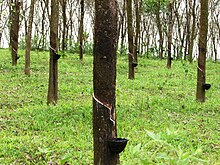

Nilambur Kovilakam
Royal family of Nilambur Puthiya Kovilakam
| |
|---|---|

Vettekkorumakan temple
| |
| Capital | Nilambur |
| Common languages | Malayalam |
| Government | Vassal state |
Nilambur Kovilakam, also known as Nilambur KingdomorNilambapuri, was a former vassal kingdom and royal Kovilakam in present-day Kerala, India, situated near to the Nilgiri range of the Western Ghats.[1] It was ruled by Samantha Kshatriyas who were the family members and representatives of the Samoothiri (Zamorin), and also established marriage relations with the Nambudiris.[2] They served as vassal kings to the Zamorin, with their capital located 25 kilometers north of Manjeri in present-day Malappuram district. They built several aristocratic Tharavads, such as the Nambudiri tharavad of Pootheri Illam in Feroke, and married into the Zamorin's own family from Nediyiruppu Swaroopam.
The family-owned Vettakkorumakan Kovil (which is famous for Pattutsavam) and Nilambur Kovilakam itself are situated on the banks of the Chali river, and the region is also known for its unique teak plantations, as well as the Teak Museum. The Nilambur – Shoranur Railway Line was built by the British Raj to carry timber and other products from these forests to the outside world.


The area was an ancient tribal settlement, and in Nilambur forests the remains of ancient temples can be found. Cholanaikkans, one of the most primitive tribes in South India and one of the last remaining hunter-gatherer tribes, numbering only 360 in 1991 and first contacted in the 1960s, have been observed in the Karulai and Chunkathara forest ranges nearby.
This article related to Kerala is a stub. You can help Wikipedia by expanding it. |
This Indian history-related article is a stub. You can help Wikipedia by expanding it. |